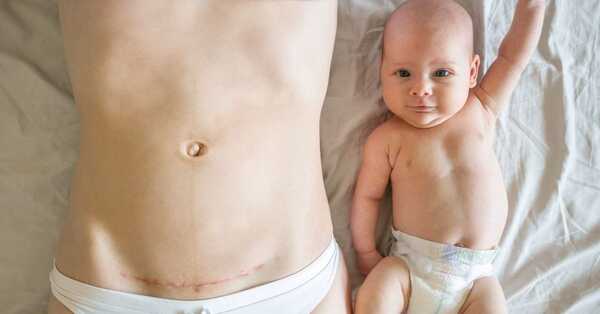
Michelle Baynham
12 Jan 2022
No woman should be suffering from c section scar pains long-term, whether it be 5, 10, 15 years on from the procedure. I find so many women just put up with the pain they may be going through and don’t tend to do anything about it. Long term or chronic c section pain should not be part of everyday life. If you’re experiencing c section scar pains such as pulling, tightness, inflammation or even bladder leakage, there are plenty of methods we can do to help your c section recovery, please don’t suffer in silence!
I recently spoke with Hannah Poulton from HLP Therapy who is a Women’s health practitioner and scar therapist who advised me a on range of tips and techniques to help relieve c section scar pains.
Cesarean recovery
The right awareness and guidance must be given to those who have just had a c section procedure and to those who are still suffering years later. Look up pelvic healthy physios, women’s health physios and scar therapists in your local area to help guide you through this period. They offer much more insight than your local GP.
For those who have just had their procedure, you come away from the hospital with your head in a blur. You have to look after a new baby while still in so much pain from the operation. You subsequently feel lost as to how to care for yourself. C-sections are the most performed surgical procedures in the world. It’s also the only surgery where you are given a human to care for afterwards, with little to no post-procedure advice.
C section wound care tips
Keep A Pillow
24 to 48 hours after your surgery, keep a pillow on you throughout the day to hold against your tummy to assist the incision whenever you move from a sitting to standing position and vice versa. Pillows work as a wonderful aid in helping protect your scare for when you need to cough, sneeze or laugh. Keep it compressed over your tummy to help support your recovery, not too tight, just firmly enough to where it’s comfortable.
24 to 48 hours after your surgery, keep a pillow on you throughout the day to hold against your tummy to assist the incision whenever you move from a sitting to standing position and vice versa. Pillows work as a wonderful aid in helping protect your scare for when you need to cough, sneeze or laugh. Keep it compressed over your tummy to help support your recovery, not too tight, just firmly enough to where it’s comfortable.
Lay on your side
Whenever you lay down, make sure to lay on your side and not your back. This avoids recruiting your abdominal muscles for when you need to stand up. These muscles will be weak and need to be rested as much as possible. When you need to stand from a position of laying on your side, roll onto your weaker side, then swing your legs over the bed or sofa and push yourself up into a seated position.
Whenever you lay down, make sure to lay on your side and not your back. This avoids recruiting your abdominal muscles for when you need to stand up. These muscles will be weak and need to be rested as much as possible. When you need to stand from a position of laying on your side, roll onto your weaker side, then swing your legs over the bed or sofa and push yourself up into a seated position.
Lifting your baby
If you have to lift your newborn at some point, get as close as your can to them, bring the baby towards you, keep your knees bent and maintain a compact, tight lift. By bending over, elongating your arms and flexing your spine, you place unwanted pressure on your lower back and this could set you back in your recovery.
If you have to lift your newborn at some point, get as close as your can to them, bring the baby towards you, keep your knees bent and maintain a compact, tight lift. By bending over, elongating your arms and flexing your spine, you place unwanted pressure on your lower back and this could set you back in your recovery.
Walking after c section: Slip-on shoes
When you start to walk again, whether in the hospital or at home, wear slip-ons, flip flops or sliders. This avoids having to bend down which subsequently recruits the use of the abdominal muscles. It also avoids having to tie laces for trainers and messing about putting them on. Plus, they are super comfy! Also, try shuffling instead of walking. Having to continuously lift your feet after surgery can be tough.
When you start to walk again, whether in the hospital or at home, wear slip-ons, flip flops or sliders. This avoids having to bend down which subsequently recruits the use of the abdominal muscles. It also avoids having to tie laces for trainers and messing about putting them on. Plus, they are super comfy! Also, try shuffling instead of walking. Having to continuously lift your feet after surgery can be tough.
Take your time
When nature calls and you feel the urge to wee, take your time!
A catheter would have been inserted during your operation to drain your bladder. When the doctors take it out, it can sometimes cause the bladder to go into a light spasm. So take your time when you wee. Shuffle over to the toilet, sit down and keep your knees above your hips. Be on your toes whilst you sit on the toilet. This helps to tilt your pelvis and opens up your back passage which allows you to go to the toilet much easier.
When nature calls and you feel the urge to wee, take your time!
A catheter would have been inserted during your operation to drain your bladder. When the doctors take it out, it can sometimes cause the bladder to go into a light spasm. So take your time when you wee. Shuffle over to the toilet, sit down and keep your knees above your hips. Be on your toes whilst you sit on the toilet. This helps to tilt your pelvis and opens up your back passage which allows you to go to the toilet much easier.
Deep breathing
Take long, deep breaths. Completely fill your lungs with air and slowly exhale through your mouth. By taking time to slow down your breathing, you’ll connect with your scare and aid your c section wound care.
Take long, deep breaths. Completely fill your lungs with air and slowly exhale through your mouth. By taking time to slow down your breathing, you’ll connect with your scare and aid your c section wound care.
Try our 3 minute deep breathing class below with Mother Fit expert advisor Sophie Belle, Breathwork Facilitator.
Drink plenty of water
Stay hydrated! You would have had an epidural in your back or some anaesthetic. It’s vital to supply your body with plenty of fluid to detox your system post-op.
Stay hydrated! You would have had an epidural in your back or some anaesthetic. It’s vital to supply your body with plenty of fluid to detox your system post-op.
Avoid the stairs
By climbing stairs, it causes to over engage the pelvis where the incision has been made. Limit using the stairs as much as you can. Spend the majority of your recovery upstairs and ask someone for help to move everything downstairs when the time comes.
By climbing stairs, it causes to over engage the pelvis where the incision has been made. Limit using the stairs as much as you can. Spend the majority of your recovery upstairs and ask someone for help to move everything downstairs when the time comes.
Do not disturb
Put a sign on the door asking couriers and postal workers to not ring/knock on the door. Avoid having to continuously move from a laying to a standing position as much as you can.
Put a sign on the door asking couriers and postal workers to not ring/knock on the door. Avoid having to continuously move from a laying to a standing position as much as you can.
These are all great tips to help with your recovery, especially when on your own.
How to look after c section scar
2-4 weeks
Let as much air as possible get to the scar. Wear loose clothing with cotton breathable fabric. Gently massage around the scar but don’t massage over it. You don’t want to disturb your bodies natural healing response.
Let as much air as possible get to the scar. Wear loose clothing with cotton breathable fabric. Gently massage around the scar but don’t massage over it. You don’t want to disturb your bodies natural healing response.
C section scar cream
For early stage c section scars, you can use NAQI Scar Repair Oil from 2-4 weeks after surgery. The oil has both a rosehip oil and linoleic acid that help with the cellular production for healing the c section scar.
For early stage c section scars, you can use NAQI Scar Repair Oil from 2-4 weeks after surgery. The oil has both a rosehip oil and linoleic acid that help with the cellular production for healing the c section scar.
6-8 weeks
Around this period is when you can start to lightly massage the scar itself. By this time, you would have had your check-up by your GP. If given the green light, start to massage over the wound.
Around this period is when you can start to lightly massage the scar itself. By this time, you would have had your check-up by your GP. If given the green light, start to massage over the wound.
What type of scar do I have?
Dependent on the type of scar you have, you should use different techniques to help with the recovery. If you have a raised red scar that is a slug shape, use a variety of circular, slide and guide motions to help with the blood flow and recovery of the area. Perform this with skin optimising oil to nourish and deepen the tissue. If you have darker skin and have a keloid scar, you should do more of a compression massage.
Try to implement all the above techniques to help alleviate pain relief after c section.

Michelle Baynham
Share this article

